Vitalik Buterin proposes that Ethereum will fail without L2. What new opportunities can the Cancun upgrade bring to L2?
Vitalik Buterin believes Ethereum needs L2 to succeed. How can the Cancun upgrade benefit L2 opportunities?2023 saw two important upgrades in the history of Ethereum. The first was the Shanghai upgrade which was completed on April 13. After the Shanghai upgrade, the beacon chain staking withdrawal function was opened, officially transforming Ethereum from a PoW mechanism to a PoS mechanism. This upgrade is an important milestone event in the Ethereum upgrade roadmap. Now, Ethereum is about to welcome the Cancun upgrade, which aims to increase more data storage for L2 to reduce costs and increase efficiency. It is expected to increase the speed of L2 by 10 to 100 times on the existing basis. According to the latest Ethereum core developer meeting, the Cancun upgrade is expected to go live at the end of this year.
How will the Cancun upgrade speed up the expansion of Ethereum and bring new development opportunities to Layer2? R3PO believes that through the Cancun upgrade, Layer2 will be better integrated into the Ethereum ecosystem, providing users with a faster and lower-cost transaction experience. Whether it is Optimistic Rollup or ZK Rollup, they will benefit from this upgrade and jointly promote the development of the Ethereum ecosystem.
1. Deterministic Future – Layer2
In Vitalik’s latest article “The Three Transitions”, co-founder of Ethereum, Vitalik, proposed that Ethereum needs to go through three major technical transitions: transitioning to L2 expansion, everyone transitioning to Rollup; transitioning to wallet security, everyone using smart contract wallets; transitioning to privacy, ensuring the feasibility of privacy-protected fund transfers.
- What are Stacks? What challenges might the BTC Layer 2 network Stacks face?
- What are Intents? What are their use cases? What possibilities exist for the future?
- Founder of Synthetix: Evolution of SNX Staking and Future Development?
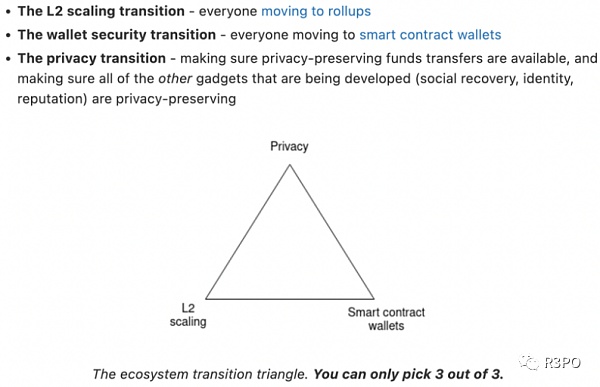
The article clarifies the importance of L2 and Rollup. Vitalik pointed out that without the development of L2, Ethereum will fail due to high transaction costs. Compared with the performance of VISA, one of the world’s famous transaction systems, which can process tens of thousands of transactions per second, Ethereum’s performance of only 15 transactions per second is difficult to meet normal transaction needs. The cost threshold of $3.75 per transaction also makes a large number of ordinary users hesitant.
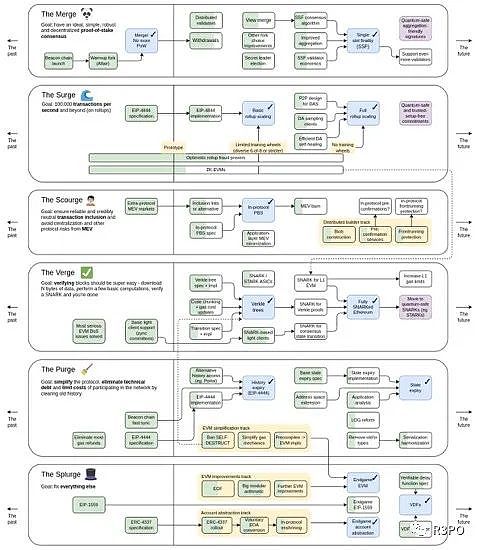
Ethereum supports a large number of transaction activities every day. As the ecosystem continues to develop, due to the limitation of block space, the network is becoming increasingly congested. The problems of high cost and low speed of Ethereum Layer1 mainnet are gradually emerging, and there is an urgent need to reduce costs and increase efficiency.
How to speed up and expand Ethereum has always been a particularly important issue for Ethereum developers. According to V God’s Ethereum roadmap, after solving the consensus mechanism problem in Shanghai, the focus will be on solving the scalability problem, with the goal of increasing the processing speed of the Ethereum network to over 100,000 transactions per second.

There are currently two scalability solutions for Ethereum: Layer2 and sharding. Layer2 is a layer-2 solution for scaling the underlying blockchain (Layer1). The principle is to execute requests on the blockchain off-chain, execute and calculate actual transactions off-chain, and then verify their validity through very few transactions on Ethereum. The current mainstream Layer2 solution is Rollup. The principle of Rollup is to package hundreds of transactions that are executed and calculated on the chain into a transaction summary, send the summary data to Ethereum, and save only the summary data without full calculation and storage on the Ethereum chain, thus achieving the goal of scaling. This way, Ethereum security can be guaranteed while also achieving scalability.
II. Optimistic Rollup VS ZK Rollup
Rollup is mainly divided into two types: Optimistic Rollup and ZK Rollup.
Optimistic Rollup uses a fraud-proof mechanism. The system defaults to executing the reliability of transaction data without the need for validity verification to enter the waiting period. During the waiting period, if any node raises an objection and provides evidence to prove malicious behavior in the transaction, the transaction will be cancelled. If there is no objection, after the waiting period ends, the transaction will be confirmed and written to the block. Through the fraud-proof transaction scheme, large-scale verification deployment is omitted, saving computing resources and ensuring the accuracy of the transaction. The current well-known solutions include: Arbitrum, Optimism.
ZK Rollup uses a zero-knowledge proof mechanism for validity proof. A zero-knowledge proof is generated to prove that all transactions are valid, and the final state change after all transactions are executed is uploaded to Ethereum. ZK Rollup does not need to upload compressed transaction details like Optimism Rollup, only a zero-knowledge proof and the final state change data are required to be uploaded. The ZK Rollup camp mainly includes ZKsync, Starkware, Scroll, etc.
Advantages and disadvantages of Optimistic Rollup:
Advantages:
Compatibility: Optimistic Rollup is relatively easy to support general-purpose contracts and compatible with the Ethereum Virtual Machine (EVM), allowing developers to more easily develop and migrate applications.
Disadvantages:
Fraud proof time delay: When there is a malicious transaction or dispute, the exit time of Optimistic Rollup is longer, usually one week, which may cause funds to be unable to flow freely for a period of time.
Network stagnation: When the network encounters disputes, the entire Optimistic Rollup network may experience stagnation, which may cause transactions to fail to proceed smoothly due to the need to wait for the processing and verification of objections.
Advantages and disadvantages of ZK Rollup:
Advantages:
Privacy protection: ZK Rollup uses zero-knowledge proof technology, which can verify the validity of transactions while protecting user privacy. Transaction details can be kept confidential, and only the correctness of the proof needs to be verified, providing a higher level of privacy protection.
Security: The verification process of ZK Rollup is based on mathematical proofs and has strong security guarantees. Through zero-knowledge proof, the validity and consistency of transactions can be ensured without disclosing the details of the transactions.
Disadvantages:
Computational cost: Generating and verifying zero-knowledge proofs requires a large amount of computing resources. Therefore, the computational cost of ZK Rollup is relatively high, which may cause longer processing times and higher computing expenses.
Limited smart contract functions: Due to the design goal of optimizing transaction processing, ZK Rollup has limited support for complex smart contract functions, and some complex contracts may not be directly implemented on ZK Rollup.
As OP has the advantage of being easier to develop and earlier to go online, it currently accounts for more than 90% of the market’s TVL, while ZK has a smaller market share. ZK needs faster construction progress and ecological construction to participate in the competition for user growth. As the Layer2 ecosystem gradually matures, after the Cancun upgrade, Rollup costs can be greatly reduced, and user growth and ecological construction may be the most critical winning factors for the competition between ZK and OP systems.
III. The future of Layer2: The way forward led by the Cancun upgrade
In the previous text, we compared the pros and cons of two Layer2 solutions, Optimistic Rollup and ZK Rollup. With the upcoming Ethereum upgrade, the KanKun upgrade, Layer2 will have new development opportunities. The KanKun upgrade is an important milestone for Ethereum, aimed at improving scalability and performance. With the KanKun upgrade, Layer2 will better integrate into the Ethereum ecosystem, providing users with a faster and lower cost transaction experience. Both Optimistic Rollup and ZK Rollup will benefit from the improvements brought about by the upgrade. After the KanKun upgrade, the speed of Ethereum Layer2 will increase by 10 to 100 times while reducing transaction costs. We have reason to expect the widespread application of Layer2 in Ethereum, which will open up new possibilities for achieving high-throughput, low-cost decentralized applications.
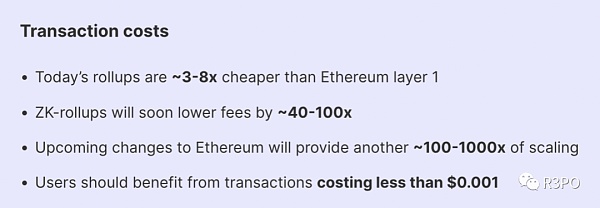
1. Main Content
The KanKun upgrade includes five EIPs, aimed at increasing more data storage and reducing costs. The upgrade is centered around EIP-4844, also known as Proto-Danksharding, which is a scaling solution based on Rollup. EIP-4844 is the first step on the Ethereum scaling path. Before the upgrade, Rollup data was permanently stored above Ethereum, and the storage cost was expensive. 90% of the transaction cost paid by users for Rollup was due to storage costs. To address this, EIP-4844 introduces a new transaction type – Blob Transaction. The data will be migrated to “Blob” for temporary storage, which lasts about one month, after which the data will be deleted. If you want to store long-term data, other service providers will store it according to actual needs. When Blob becomes part of the Ethereum protocol through Proto-Danksharding, more Blobs may be added to the Ethereum block, and Ethereum’s throughput will once again be greatly expanded (>100 times), while transaction costs will also decrease.

EIP-4844: As the core of the KanKun upgrade, EIP-4844, also known as Proto-Danksharding, is a scaling solution based on Rollup. EIP-4844 is the first step on the Ethereum scaling path. Before the upgrade, Rollup data was permanently stored above Ethereum, and the storage cost was expensive. 90% of the transaction cost paid by users for Rollup was due to storage costs. To address this, EIP-4844 introduces a new transaction type – Blob Transaction. The data will be migrated to “Blob” for temporary storage, which lasts about one month, after which the data will be deleted. If you want to store long-term data, other service providers will store it according to actual needs. When Blob becomes part of the Ethereum protocol through Proto-Danksharding, more Blobs may be added to the Ethereum block, and Ethereum’s throughput will once again be greatly expanded (>100 times), while transaction costs will also decrease.
Other selected EIPs include:
EIP-1153: Reduce the cost of on-chain storage data to improve block space.
EIP-4788: Improve the design of cross-chain bridges and equity pools.
EIP-5656: Add minor code changes related to the Ethereum Virtual Machine.
EIP-6780: Remove code that may terminate smart contracts.
2. Which opportunities are worth paying attention to?
① The grand narrative of Layer2
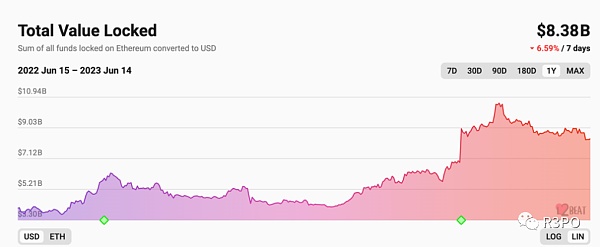
The current congestion of Ethereum has also created the grandest narrative. The total TVL of the L2 ecosystem has increased by more than 100% since the beginning of the year and has reached about $8 billion. The first step of the Ethereum expansion, the Cancun upgrade, will make Layer2 10x-100x faster and cheaper. The scaling and low fees of EIP-4844 will benefit various L2 ecosystems. The OP ecosystem will become more diversified, the ZK ecosystem will be more available because of the enhanced data availability, and independent Layer 2s that are difficult to operate at high costs will grow rapidly. With the reduction of on-chain fees, the L2 ecosystem will become more abundant, and the number of users will increase.
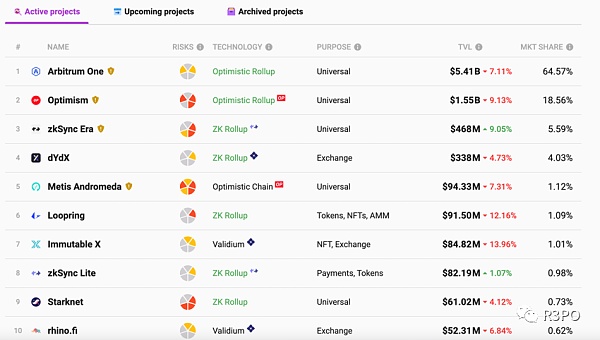
Among the projects already online, Arbitrum, OP, the newcomer ZKsync, and the old application dYdX occupy half of the current L2. The leading protocols in the hot track will have greater potential after the Cancun upgrade.
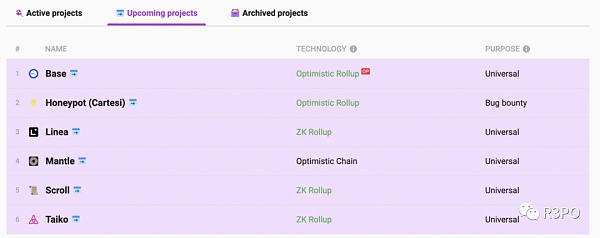
In addition to the projects that have been launched, those that will soon launch mainnets such as Scroll, Linea, and Taiko are also worth paying attention to.
Moreover, faster transaction speeds and lower transaction costs on L2 will inevitably promote a new round of projects on L2. On-chain futures, on-chain options, and projects that require high transaction speeds, such as GMX and GNX, which are easily affected by the low TPS of Ethereum, will be significantly improved by the Cancun upgrade, and their development space will be further expanded.
② Data Availability (DA) Track
Because Blob data can only be saved for a short time, there are problems with calling historical data. This creates a demand for decentralized storage, and the Layer 2 scaling solution also needs to use the Data Availability (DA) layer. In addition, the Cancun upgrade will also benefit L1 storage extension networks such as Eth storage, Arweave, Filecoin, and other Ethereum DA layer projects.
3. Where is Layer2 heading?
In the foreseeable future, with the trumpet of Ethereum expansion sounded by the upgrade of CanQuan, expansion will provide higher throughput and lower transaction costs. This will allow Layer2 applications to process more transactions and provide users with faster, real-time transaction confirmations. Whether it is in the financial field for payments and settlements or in games and NFTs, the high performance of Layer2 will provide users with a smoother and more efficient experience.
However, technological progress alone cannot attract users. Innovative applications are essential to achieve the true prosperity of Layer2. According to L2beat data, there are currently 29 Layer2s that have been launched or are under development and waiting to go online, among which Arbtirum One, Optimisim, zkSync Era, and dYdX account for 92.75% of the market share, while other L2s share the remaining 6.25% of the market share.
It’s like spending a lot of time and energy repairing a highway, but because there is no demand, there are only a few cars driving on the highway, which is a problem most L2s face. Without high-quality applications, the value of L2 cannot be reflected. Arbitrum gradually builds a prosperous ecosystem because of the rise of DeFi applications such as GMX. Only by developing more convenient, innovative, and practical applications that meet users’ needs can we truly attract users’ attention and participation. This requires developers and entrepreneurs to boldly try and innovate on Layer2, combining the advantages of Layer2 to create unique and attractive application scenarios. Only in this way can Layer2 truly integrate into users’ lives. Therefore, in addition to technological development, user migration and application promotion are also key factors for the future success of Layer2.
We will continue to update Blocking; if you have any questions or suggestions, please contact us!
Was this article helpful?
93 out of 132 found this helpful
Related articles
- How is Terra’s ecological disaster reconstruction? Learn about the development status of LUNA 2.0 in this article.
- Stablecoin Dashboard: Classifies nine stablecoins based on volatility risk
- Conversation with Scroll and Cysic Co-founders: Proof-of-Stake Network and ZK Hardware Acceleration
- How to break the interoperability trust problem by in-depth analysis of any message passing protocol?
- EN: Binance has requested “Binance Nigeria Limited” to cease operations.
- Hayden Adams: Looking back at the history of Uniswap, there have been many unsettling moments.
- What are the principles and changes in Uniswap v4, an important piece of DeFi puzzle?





